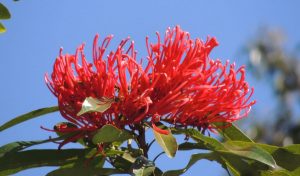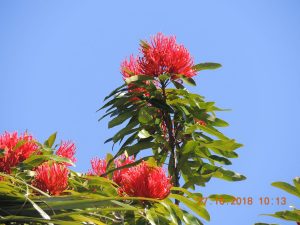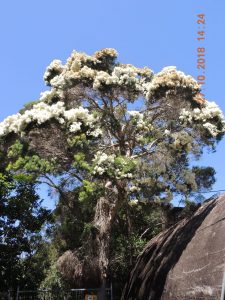Flowering Trees – Tree Waratah and Snow In Summer
Paluma gardens never cease to surprise and delight with the variety of spectacular blooms to be found here. In the garden of No. 15 Mount Spec Road, the brilliant red flowers of a Tree Waratah flame in the crown of this tall, slender tree. Higher than the house roof, the flowers can be easily missed unless you are scanning the tree-tops for birds.

Native to the North Queensland rainforest, the Tree Waratah and its natural habitat on the Atherton Tableland, have largely disappeared there due to clearing for grazing and agriculture. The tree is known for its beautiful pink timber.
Formerly known as Oreocallis wickhamii, it has undergone a name change and is now classified as genus Alloxylon in reference to its unique timber. There are two species within the Queensland tropical rainforest – Alloxylon flamelleum, (which I suspect is the species flowering in the Paluma garden), and Alloxylon wickhamii. The common names for these trees are Queensland Waratah, Pink Silky Oak and Red Silky Oak for A. flamelleum and Tree Waratah, Satin Silky Oak and Pink Silky Oak for A. wickhamii. All very confusing to a non-botanist: so much easier to identify it as ‘Tree Waratah’.

Take a short walk from Mount Spec Road along Lennox Crescent to the Townsville City Council Water Depot. Look up the driveway to see, rising behind the buildings and tower, a magnificent Melaleuca tree, its crown completely covered in dense white bloom. It gives the impression of being heavily snow-laden. This tree is Melaleuca linariifolia and not surprisingly, one of its common names is ‘Snow in Summer’.
 This small evergreen tree grows to a height of 6m to 10m. It is from the myrtle family and is endemic to New South Wales and Queensland. This particular specimen was planted in the early 1990’s (in 1993 or 1994) by long-time Paluma resident Kelly Davis. The trunk of this tree has thick sheets of papery bark. The flowers are a major attractant for bees, butterflies and birds.Unfortunately, the spectacular display of the ‘Snow in Summer’ will not last long; already some of the blooms are browning in the tropical heat.
This small evergreen tree grows to a height of 6m to 10m. It is from the myrtle family and is endemic to New South Wales and Queensland. This particular specimen was planted in the early 1990’s (in 1993 or 1994) by long-time Paluma resident Kelly Davis. The trunk of this tree has thick sheets of papery bark. The flowers are a major attractant for bees, butterflies and birds.Unfortunately, the spectacular display of the ‘Snow in Summer’ will not last long; already some of the blooms are browning in the tropical heat.

Text by Colwyn Campbell & Photos by Michele Bird
